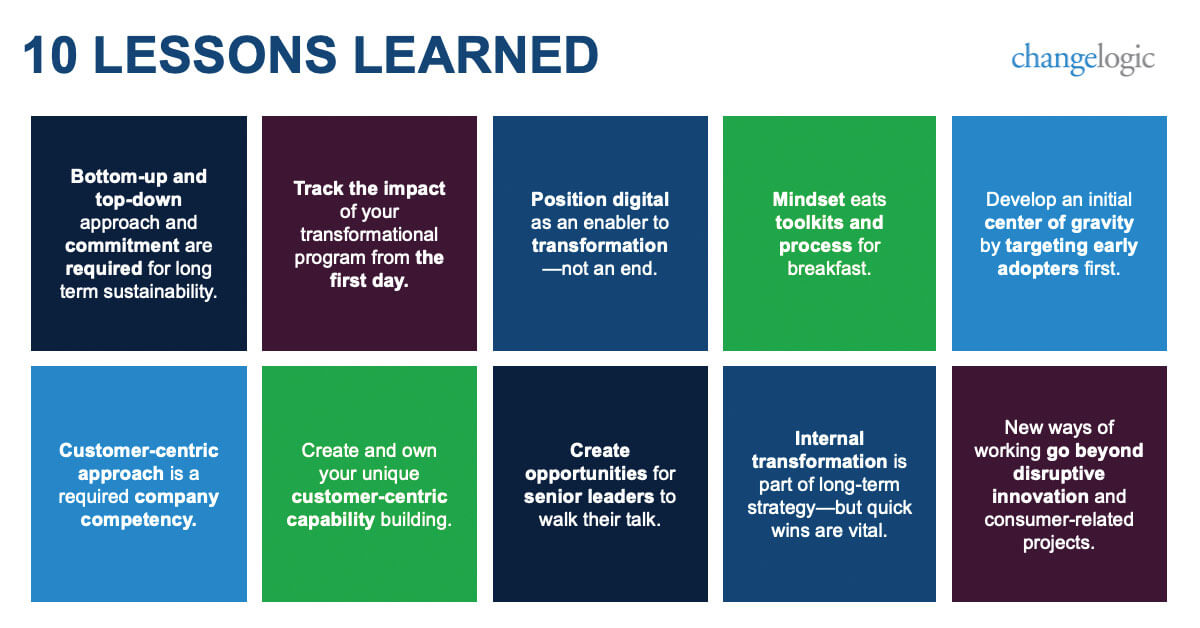“Corporate Explorer – How Corporations Beat Startups at the Innovation Game”, the upcoming book co-authored by Andrew Binns, Professor Mike Tushman, andProfessor Charles O’Reilly, tells the stories of leaders – Corporate Explorers – who drive innovation inside existing corporations, able to create a transformational movement conducting to successful new ventures and company growth.
Having been a Corporate Explorer myself in a very recent past at Philip Morris International, I’m thrilled to kickoff our 2022 Change Logic Blog series by sharing the 10 lessons I learned during my challenging but exciting role.
10 Lessons Learned
- Bottom-up and top-down approach and commitment are required for long term sustainability. While getting the sponsorship from senior leader(s) seems obvious to help you face the possible bump lines and remove obstacles along any transformation journey, making employees naturally embrace the change is also crucial to ensure its anchorage over time. The activation of local enablers gathered into self-engaged communities is priceless.
- Track the impact of your transformational program from the first day. Human resistance to change is natural and will come sooner or later, maybe even faster than you expect, especially when it touches to people’s behaviors and habits. So, it is better to define up front how you will measure and track your progress (and not only your success) towards the desired outcomes to better confront future resistance (including from middle-management and senior level).
- Position digital as an enabler to transformation—not an end. Any corporate transformation should be the result of a bold ambition driven by business objectives rather than technology. You don’t digitalize a business for the sake of digitalizing it. A digital transformation should instead be a business transformation enabled by digital innovation and technologies.
- Mindset eats toolkits and process for breakfast. Mindsets shape how people see and interpret their world, and leads to typical pattern of thinking and behaving. If you try to change people’s habits without demonstrating why and how the proposed changes might be beneficial for them (“what’s in it for me”) – the prevailing mindset will continually resist. Mindset shift is driven by humans and not by tools or process.
- Develop an initial center of gravity by targeting early adopters first. As mentioned before, resistance to change is a natural human-reaction, and amplified more when the change affects human habits and behaviors. Therefore, your chance to succeed in a transformational movement will be higher if you target your early adopters first, developing an initial center of gravity. Do not waste your initial time and effort giving water to people who are not thirsty. Starting small with early adopters will also help you to quickly pivot your approach in adapting it to your employees’ needs. Fail early and often. Learn quickly from your early adopters through real tests
- Customer-centric approach is a required company competency. In this fast-changing world, customers have superpowers and huge expectations beyond products and services. As a result, human-centric principles should be at the heart of any new corporate’s way of working. This is a must-, not nice-to-have. For innovation today, customer-centricity is necessary for an organization’s ability to survive disruption.
- Create and own your unique customer-centric capability building. Outside expertise is usually beneficial for kicking-off your journey towards a new way of working. However, corporates should leverage this external help to build their own muscles (i.e., capabilities and capacity). They should also consider creating a bespoke capability that reflects their corporate’s size and ambition, as no solution fits all. Doing so will prevent them from future dependency on the outside, and make the results of their efforts sustainable and anchored over time.
- Create opportunities for senior leaders to walk their talk. Corporate Explorers do not wait to be assigned the job of innovation; they secure support from senior leaders for pursuing the opportunities they see. However, they do need senior leaders that “walk the talk”, i.e., explicitly crossing the line between saying and doing, and demonstrating their own adoption of new ways of working. Transformation must happen at all levels in order to succeed. Otherwise, the peek of hope will be quickly followed by the trough of disillusionment.
- Internal transformation is part of long-term strategy—but quick wins are vital. Projects are typically characterized by a start and end date; however, a corporate transformation journey does not have usually an end date. Consequently, you’re embarking on a journey that might not always be well understood and perceived by others (especially middle-management and senior leaders) and usually exposed to fine-planned corporate programs and projects. Demonstrating quick wins, thanks to your early adopters (see #5), will help you keep away (for some time only) possible detractors whose voice might be amplified by resistance to change (see #4 and 8).
- New ways of working go beyond disruptive innovation and consumer-related projects. While initial efforts of transformational movement usually focus on the areas and functions that deal with new consumer products or/and business models, they should not be limited only to these. Adopting customer-centric and agile ways of working may provide beneficial to any corporate area and function regardless if their customers are external (consumers, partners) or internal (employees), and even if their scope is to think big or improve existing business.. Your early adopters and accompanying quick wins (see 5 and 9) could thus come from your core business.

As Corporate Explorers or leaders developing a corporate’s new way of working, have you gone through similar lessons, or some other ones you would like to share?
How do these lessons learned resonate with your current journey and experience?
I would love hearing back from you.
